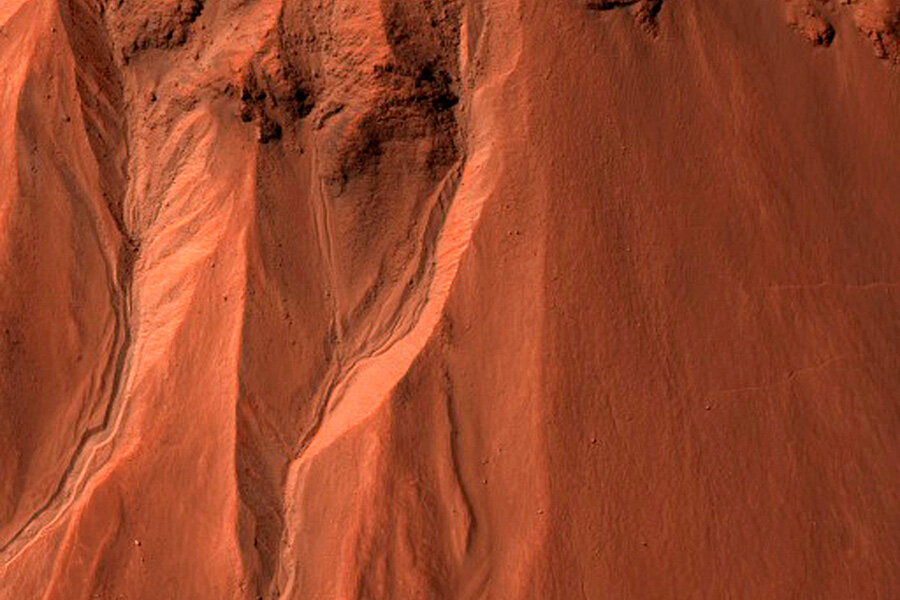Young crater on Mars hints at Earth-like climate
Loading...
Mars is a planet of paradoxes, red in color but icy cold. Did its climate ever resemble that of our warm, blue planet? Maybe so, suggests a new study of Istok crater – and not billions of years ago, but in the recent geologic past.
A study led by Tjalling de Haas of Utrecht University has found that the gullies in Istok crater are similar to those on Earth, and could have formed during recent periods of high orbital obliquity.
Istok crater, located in the Aonia Terra region of Mars, has remarkably well-preserved debris-flow tracks, or gullies. These are the first tracks imaged clearly enough to allow scientists to calculate the amount and frequency of water that flowed through them. As he told the Monitor, this is "really something new!"
Debris flows, such as mudslides and avalanches, differ from pure-water flows in that they contain about only 20-60 percent water, located in the tiny gaps between the rocks and dirt.
Once the scientists had calculated the amount of water necessary to create the gullies they observed, they could estimate the amount of snowfall necessary to generate that much water.
Previous research concluded that these tracks could have been carved with just millimeters of water, but Dr. de Haas disagrees. His team calculated that inches or even feet of snow had to pile up at the heads of these valleys in order to explain the debris flow patterns visible in the images taken from orbit.
The Martian climate is currently quite dissimilar from Earth's climate, with very cold temperatures and an almost nonexistent atmosphere. Most of the known water on the planet is frozen at the poles or hidden in deep underground springs. But finding debris flow tracks in a crater that is less than a million years old – their best estimate dates the crater impact to about 190,000 years ago – demonstrates that temperatures were warm enough in the recent past to allow ice to melt, at least in that region.
How could that happen? De Haas theorizes that these Earth-like debris flows occurred at times of high orbital obliquity, because when Mars's axis is tilted more dramatically, it can have much hotter summers (and colder winters) than the present.
While Earth’s axis has remained relatively constant over its history, only shifting between 22.1 to 24.5 degrees (thanks to stabilization from our large moon), Mars has bobbled like a top over tens of millions of years, moving between an almost vertical axis down to an axial tilt of more than 60 degrees. Its axis is currently tilted 25 degrees, but during high obliquity intervals, Mars is lying down almost sideways with respect to its orbit, like Uranus does.
It's still uncertain exactly how much these dramatic changes in axial tilt affect Martian climate, but for comparison, a one degree change in Earth's axis may have ended the ice age, melting glaciers from New York City to Greenland. It's not unreasonable to conclude that massive axial swings on Mars could lead to greater climate variation, creating conditions where snow and ice can first accumulate and then melt, causing debris flows.
This study, published in the current issue of Nature Communications, contributes to the emerging understanding of the dynamic climatic history of the red planet; if these results are replicated in other areas around the planet, it may turn out that Mars was once much more habitable than it currently is.
However, de Haas cautions that his team identified only “a local occurrence, and only during very short periods at high orbital obliquity.” More research is necessary, he adds, to determine whether these conditions were present elsewhere or whether they only speak to an isolated, transient incidence of climate conditions like those on Earth.








